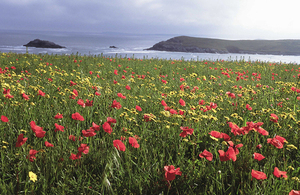Innovative approach to Farming Recovery Fund helps reopen Curry and Hay Moors on the Somerset Levels
The western edge of Curry and Hay Moor Site of Special Scientific Interest (SSSI) on the Somerset Levels has reopened for farming with the support of a grant from Defra’s Farming Recovery Fund to local farmers.

The area’s farmers have been working with Natural England and Defra to secure funding for the renovation of the drove at Curry Moor after it was rendered impassable to machinery following last winter’s flooding.
The drove provides essential access for haymaking, silaging and for the livestock that grazes Curry and Hay Moor SSSI. As well as being a farmed landscape, the area is designated as a SSSI for its internationally important numbers of overwintering wading birds, such as lapwing and snipe.
As no single farmer owns the drove and no individual farmer could afford to pay a contractor up-front, applying for funding from the Farm Recovery Fund (FRF) brought complications not previously faced in the Somerset Levels farm flood recovery work. Working with Natural England’s local adviser, Claire Stride, and the FRF team, the solution was for the farmers to submit an innovative ‘communal’ application to the fund.
Local farmer, Richard Kearn, agreed to be the lead applicant for the collective application and was delighted that the application resulted in a grant of £74,700 from the Recovery Fund to support the essential works.
Mr Kearn said: “The drove repair was a significant project because the total length of the drove is about 2,262 metres and a regular stream of heavy lorry loads of stone was needed to repair the worst of the damage caused by the flooding. I would like to say thank you to anyone inconvenienced during the works for their patience and also thank Claire Stride and Natural England for all their support.”
Andrew Sells, the Chairman of Natural England added: “Natural England is very proud of the farmers who graze their stock on Curry and Hay Moor and of the work that they do on the site, which makes an invaluable contribution to the management of the SSSI.
“Following the winter’s flooding farmers faced the possibility of being unable to access their fields, but I’m pleased we were able to find a solution that worked for everyone and ensured that farming operations could quickly return to business as usual.”
Farming Minister George Eustice said: “The local community has really got behind this project to get livestock back on Curry and Hay Moor where they will continue to support the management of one of our most valuable natural habitats. Our Farming Recovery Fund is helping hundreds of farmers across the country to repair damage caused by last year’s floods and get their businesses back on track.”
The funding provided to restore the drove under the Farming Recovery Fund has been welcomed by the local community and has proved to be an excellent example of flexible partnership working between farmers, Natural England and Defra.
The process can now be repeated on other sites in the area, such as Wet Moor, helping to save farmers time and money and ensuring that some of the best wildlife sites in the area can continue to be managed successfully for farming and wildlife.
For further information (media enquiries only) please contact: David Hirst, Natural England press officer: david.hirst@naturalengland.org.uk Twitter: @NaturalEngland
Background information
The Somerset Levels and Moors is a wetland area spanning around 29,000ha of the River Parrett Catchment and the River Brue Valley in Somerset. It is the largest area of lowland wet grassland in the UK.
Natural England currently invests around £2.2 million per annum in the Somerset Levels through payments to farmers under Defra’s Environmental Stewardship scheme. We currently have Higher Level Stewardship agreements with 325 land managers worth £2.2 million per annum.
Approximately 7,000ha of the lowest lying areas are designated as 14 SSSI. Of this 6,300ha (12 of the SSSI) are designated as internationally important wetland (Special Protection Area/Ramsar) for migratory wildfowl under the Habitats Directive and Ramsar Convention. The designations are the result of conservation concerns which arose as a result of increased drainage and agricultural intensification from the 1950s to the 1980s.
Curry and Hay Moor is the first moor on the Somerset Levels to be flooded in the winter months and the last to be drained due to its position along the River Tone. Normally dry during the summer months, it was badly flooded in the summer of 2012 resulting in the loss of thousands of acres of grassland and substantial costs to the farmers to reseed the land.
There are 4,129 SSSIs in England, covering around 8 per cent of the country, many of which cover the most loved, and often visited, parts of England. The aim for every site is to achieve an assessment of favourable condition, which means that the specific features for which a site is notified have reached nationally recognised goals for habitat quality or species abundance. Each SSSI is unique and a SSSI can be notified for its important natural habitat, distinctive species of wildlife, or for an exceptional geological formation.